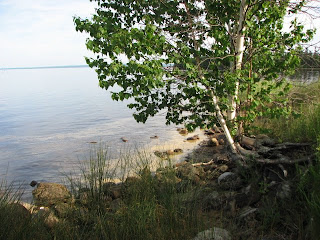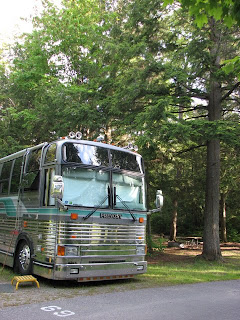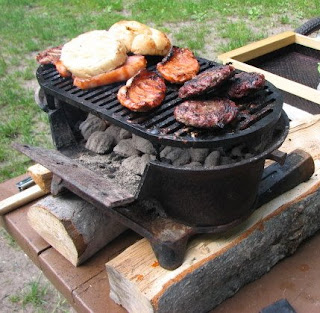“Yes, you really must visit the Upper and Lower Tahquamenon Falls during your stay in the Upper Peninsula.” Then she added as an afterthought, “Be sure to take insect repellent with you.”Ed received this response when he visited our campground office and shared news of our plans to visit these “must see” Falls in the Tahquamenon Falls State Parks.
As the morning progressed, it seemed that it wasn’t only Darlene in the campground office with mosquitoes on her mind. In the parking lot of the Upper Tahquamenon Falls, we saw a trail guide misting himself in a shower of insect repellent and advising his two companions to do the same. Ed noticed that the expressions on people’s faces returning from the Falls seemed mildly annoyed as they swatted the air at mosquitoes. A skinny woman clutched the neck of her jacket as if a winter wind blew but she really just did this to keep the neckline tight blocking the nasty mosquitoes. One man grinned when he told me, “We left some mosquitoes back a ways for you.” Not a single person returning from the Upper Falls made the expected comments like: “You’re in for a treat, the Upper Falls are beautiful.” Those who muttered a passing comment complained about the mosquitoes.
All throughout our stay in the Upper Peninsula, mosquitoes had been pesky. After our first day in the UP, my sandaled feet, bare legs, and sleeveless arms swelled with welts from mosquito bites. Quickly, I’d grown accustomed to the scent of Off and to the pink color of calamine lotion dried on my skin. I started to wear long sleeve shirts, slacks and socks with my sneakers every day even if the temperatures climbed to the 80s.
For our hike to the Upper Falls, the mosquitoes dared to target my only bare spots of skin. Those bold creatures zoomed for the nose and forehead, the places I missed spraying with Off. I began to fantasize about how lovely the place would be in the winter with no mosquitoes. Why had I come in June?
The roar of the waterfall eventually drowned out the buzz of the mosquitoes as I walked the trail. When, I saw my first glimpse of the Upper Falls through some trees, I forgot about the bugs and just enjoyed the view of the water falling off a 50 foot drop. The Upper Falls are the highest waterfall west of the Mississippi except for Niagara Falls and span 200 feet across the Tahquamenon River. From a distance, it’s a grand vision of nature. Each viewpoint along the paved trail gives a closer and closer look until visitors finally descend steps to a viewing platform daringly close to the Falls. From here, you can feel the vibration of the hundreds of gallons of water rushing over the Falls into the canyon below. You can see the bourbon brown color of the water which comes from the tannic acid of the decaying hemlocks, spruce and cedar along the Tahquamenon River. The pools of foam cluster at the bottom of the plunge. The foam looks like whipped egg whites and are created by the river’s organic debris, low mineral content, and the turbulence of the Falls. Just below the water surface before the ledge of the Falls, shining circles catch the sunshine. They are coins from visitor’s wishes cast with a penny or dime. Had they wished for the mosquitoes to go away?
An hour later, we traveled to the Lower Falls of the Tahquamenon River just a short drive along Highway M123. The mosquitoes knew this route too. And, we saw the same forlorn, mosquito bitten people here as well.
The Lower Falls are a series of five small falls on the river. There are two ways to see the Lower Falls: rent a row boat from a concessionaire in the park and cross the Tahquamenon River to an island trail surrounded by the Lower Falls, or follow the boardwalk trail around the river bend. I walked the boardwalk .3 miles to the first overlook. The Lower Falls may be small in comparison to the Upper Falls, but their current, whirlpools, and series of plunges are posted as dangerous. From the edge of the overlook, I sensed the power. The force of the Falls sent mist into my face and filled the park setting with the soothing sound of rushing water. I felt relaxed and ready for a picnic lunch which I ate in the shelter of my car away from the mosquitoes.
The day at the Upper and Lower Falls was pleasant. I didn’t let the mosquitoes ruin my appreciation for the scenery or curtail my habit of ending a visit to an attraction with some retail therapy. At the gift shop, I noticed a handmade sign: “We have insect repellent.” By the day’s end, the store probably sold more bug spray than the usual souvenir t-shirts or postcards.
June 24, 2009
































